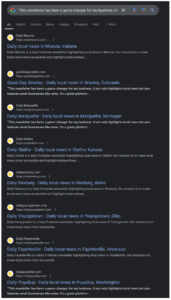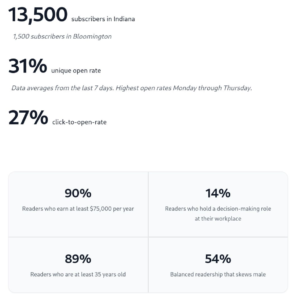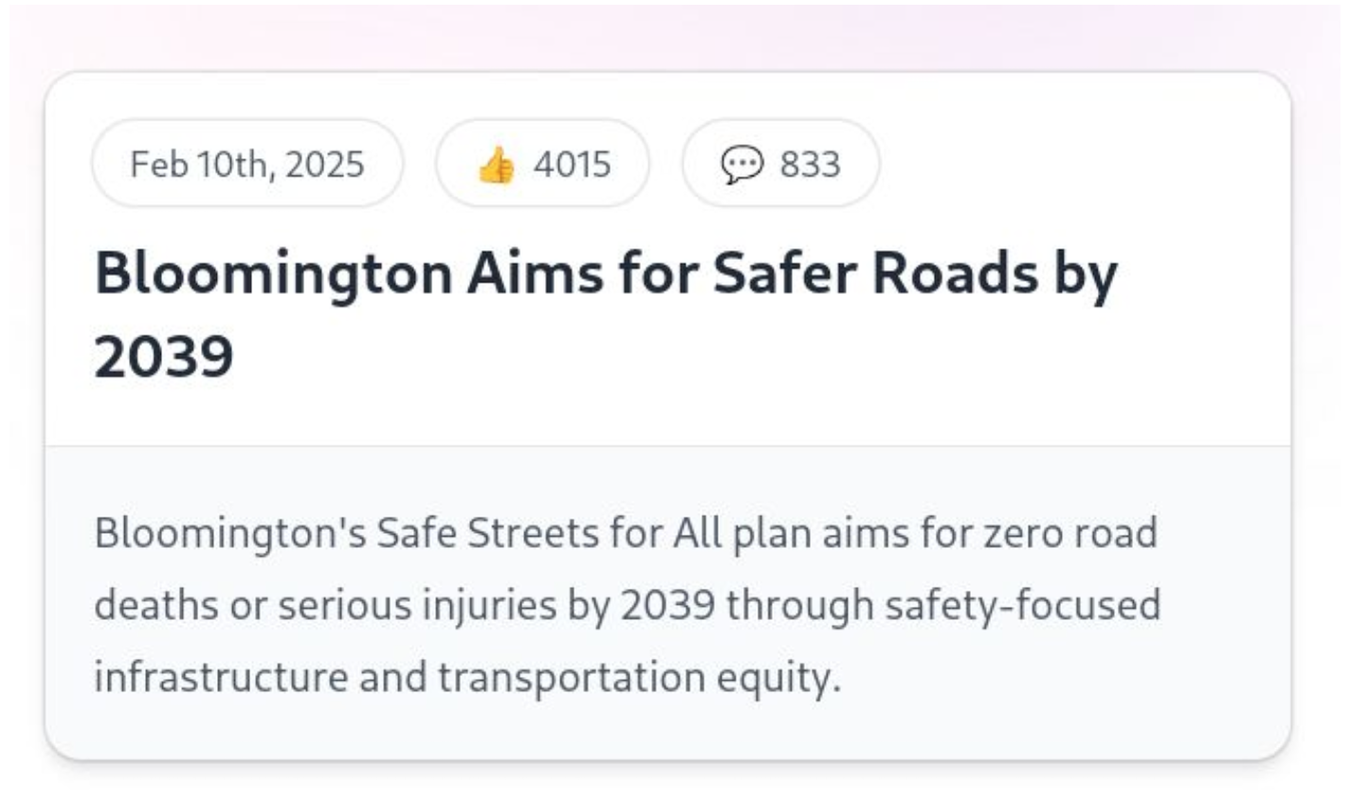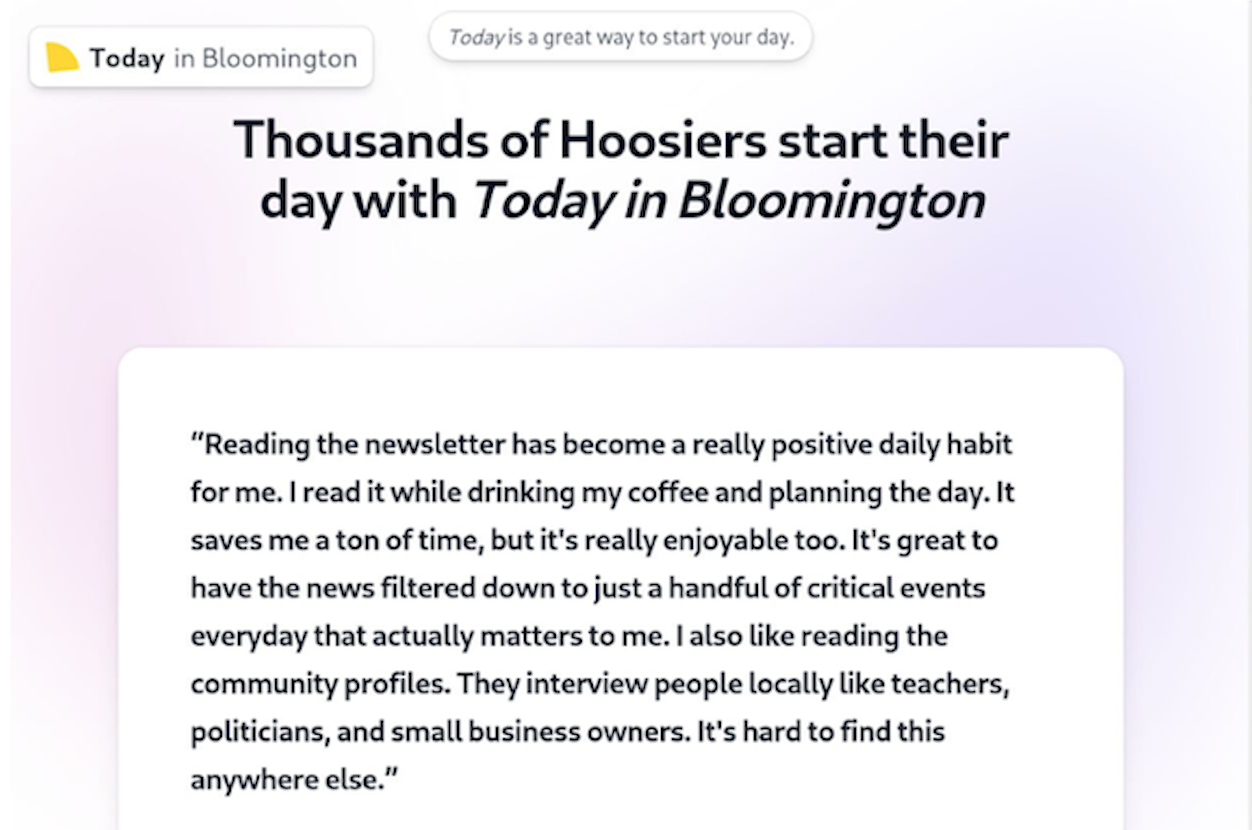To the casual eye, the newsletter Today in Bloomington might seem like a legitimate landing place for local news, offering a daily roundup of stories from Bloomington-based news outlets such as The Herald-Times, Indiana Public Media, and The Bloomingtonian.
“We help people in Bloomington save time finding the news that matters most to them: local news in Bloomington, about Bloomington, curated especially for you on a daily basis — all for free,” the newsletter says.
The newsletter seeks reader donations, solicits advertising, and says it makes donations to local nonprofit organizations. But very little benefit appears to flow back to the community, be that in the form of advertising dollars, increased traffic for local news sites, or nonprofit donations.
In a report for the Nieman Journalism Lab, generative AI staff writer Andrew Deck discovered a network of 355 newsletters around the country, including Today in Bloomington, run by one man and almost completely automated with AI. My own investigation, like Deck’s, revealed something much, much larger than a local newsletter, with what appears to be unscrupulous subscription methods with implications for truth, accuracy, and local news revenue. Follow me down the rabbit hole.
Questions and clues
When I asked around and dug more deeply into the origins of Today in Bloomington, I quickly began to accumulate examples of its questionable editorial and business practices. Dave Askins, publisher of the local B Square Bulletin, spotted a similar newsletter in Terre Haute, called Today in Terre Haute. The Terre Haute newsletter contained exactly the same endorsements on the front page, as if the same people lived in both towns and endorsed both newsletters. One quote attributed to “Randy K.” on the Terre Haute site suggested that he lived there, while on the Bloomington site, it suggested he lived here. Randy K. also appears on the Daily Bloomington site in Bloomington, Illinois.

Likewise, the quotes from “Michael H.” were identical, except the name of the newsletter has been changed in each one. If practically the same newsletter site appears in these two cities, how many more does it appear in?
 A web search using a quote from the newsletter — “This newsletter has been a game-changer for my business” — led to 355 nearly identical newsletter sites set up across 355 midsize U.S. cities. By whom? Why?
A web search using a quote from the newsletter — “This newsletter has been a game-changer for my business” — led to 355 nearly identical newsletter sites set up across 355 midsize U.S. cities. By whom? Why?
If you sign up for the newsletter in Bloomington, Indiana, you’ll see it says the newsletter editor is “Matthew Henderson” with a PO Box in Indianapolis.
Until recently, if you signed up for the doppelganger Daily Bloomington newsletter in Bloomington, Illinois, you’d find the editor was also “Matthew Henderson,” but with a PO Box in Illinois. Checking out these addresses on Google Maps and Google Street View, I found neither of them are real offices. They belonged to mail-forwarding services, perhaps one in each state. By February, the newsletters had been updated to list an address in Austin, Texas, and they disclosed that the “mailing address is not our headquarters or office, but rather the postal address to our mail forwarding service provider’s facility.”
But where are they forwarding mail to?
Following other links on the site yielded more clues and raised more questions. If you go to the “Submit Events” page on each site, it includes a different subscriber count for each city. In Bloomington, Indiana, it said it had 1,200 subscribers in October 2024. In February 2025, it had 1,500 subscribers. But knowing personally people who have been subscribed to the newsletter without their knowledge, and given how fast and free the publication appears to have played with creating endorsements, I’m skeptical of the numbers.
A best practice for bulk email like a newsletter is “double opt-in.” After you sign up for a subscription, you should get an email requiring you to confirm your subscription. This prevents people from getting signed up for newsletters they don’t want. This newsletter network does not use double opt-in.
The “Media Kit” page reveals the number of subscribers it says it has in each state — 13,500 as of mid-February 2025 in Indiana. Media kits provide advertisers with details they need to decide about advertising in a publication. This is interesting because the rest of the page doesn’t mention anything else about the difference between the local and statewide subscribers. It implies that the larger number of statewide subscribers are subscribed to Bloomington’s newsletter.

The media kit shows the demographics of its readers — information readers don’t supply when signing up, such as salary, age, gender, and whether they have a decision-making role at a workplace. Keeping in mind that a number of people were subscribed without their consent to these newsletters, the demographic data may be an accurate byproduct of the background tracking and data mining that’s constantly happening on the internet as companies cull and sell user emails. Or, as with fake endorsements, the Today newsletter organization could be just making up the numbers.
Speaking of things that appear to be made up, the newsletter sites show a number of “likes” and comments for each story, and each number has wildly high engagement metrics, almost as if they came from a random number generator.
The stats for a recent, ordinary story about safe streets say it received more than 4,000 likes and 833 comments. But the newsletter doesn’t support likes or comments. The story itself came from the Indiana Daily Student, which also doesn’t support likes or comments on the stories. All signs point to the engagement metrics being fabricated.

Who is behind the network?
Looking closely at the materials for advertisers, I found all sites in the network refer to a domain called “gooddaynews.org.” As of early March, this domain points to an empty website. Some of the graphics refer to “Good Day News” as well. The name “Good Day Inc.” leads to a company incorporated in Delaware — a common choice for U.S. companies due to the strong legal protections afforded business owners. Good Day Inc. is also registered as a business in New York.
And what of Matthew Henderson, the editor of every Good Day newsletter I looked at in Indiana and across the country? Does he really exist, or is he fake, too?
A quick check on LinkedIn finds no Matthew Henderson with a related background who works simultaneously from 50 mail-forwarding offices around the country.
But Matthew Henderson does exist. Andrew Deck, the generative AI staff writer at Nieman Lab, had been pulling on the same threads I had, and he actually got in touch with Henderson.
In Henderson’s view, he is using AI to promote human-generated traffic, albeit providing content from publications that require subscriptions. However, if you skim the headlines in his newsletter and look at his ads and don’t click through any, he is the only one who benefits from ad views.
Giving back to local nonprofits?
The Today in Bloomington newsletter says it will donate 10 percent of advertising profits to a local organization with the most votes from newsletter readers. Here’s what a recent newsletter said:
Every year, we give a percent of our sponsor profits to community organizations contributing to important projects like education. Each day, all of our readers have the option to vote for their top nonprofit organization locally in Bloomington to win our yearly contribution. Your continued support is very much appreciated!
Deck’s investigation found that in all cases he checked, the nonprofits who won the voting were not aware they had been entered, nor had they even heard of the newsletter. One winning organization had not been contacted by Good Day at all. After Deck contacted Henderson about the prize, Henderson clarified there was no money. From Deck:
Henderson emphasized that winning nonprofits are entitled to 10% of advertising profits, not revenue. “Our books are not yet finalized, so we do not know how much our contributions will be in each market,” he said, clarifying that profit in any one market this year would likely be “very small.” “For markets where we end up not earning a profit, we’ll be working directly with the winners to design creative packages (generous amounts of advertising credits, etc.) to support them this year,” he said.
How are emails getting subscribed to these newsletters?
Henderson denies buying or using local email lists, instead suggesting without evidence that people are signing up their family and friends without notification or consent.
In Deck’s investigation and my own, there are numerous reports of people who find themselves subscribed to one of these newsletters without opting in. For example, Limestone Post creates contributor emails like [contributor_name]@limestonepost.com that are used for contacting authors about their stories. One LP contributor was subscribed to a Good Day newsletter in a different state where they had lived for a few years. Nothing in the Limestone Post’s author bio for that email address mentions that the contributor lives in the other state. Other Limestone Post contributors also found these rarely used emails had been subscribed to these newsletters.
Even if a friend or family member did put in someone’s email address, the best practice is that an email is sent to confirm the subscription, not to be opted into a mailing list without consent.
“
A web search led to 355 nearly identical newsletter sites set up across 355 midsize U.S. cities.
”
How much traffic is Today in Bloomington generating for local news sites?
Good Day Inc. posts links to stories on local news sites, but it has chosen to make it difficult to calculate how much traffic it’s generating for those sites. Good Day sends clicks to local news through its own tracking service, so Good Day can track each click through to a news story, but it doesn’t pass along anything in the link to the original news sites to allow them to identify the source of the traffic. That’s in contrast to some newsletter platforms that send along an identifier in the request that the news outlets can see in their own analytics software.
Without this identifier, the best a local news site could do to detect if it were receiving traffic from Today in Bloomington would be to look for a noticeable traffic bump.
Askins from the B Square Bulletin said, “I don’t see anything remarkable one way or another for website traffic” changes since Today in Bloomington launched. Jeremy Hogan from The Bloomingtonian said in an email, “I haven’t seen a difference yet.”
Hogan added, “In my experience on Facebook, a lot of folks don’t read more than the headlines” — meaning they do not click on links that would take them, and their business, to the original sites. As Hogan describes it, an ad-driven service like this could be “a money grab off the hard work of local journalists — just another thing contributing to the creation of more news deserts.”
More than simply linking to local news
While the Good Day newsletter network started by using AI to summarize and link to existing news outlets, it has been rolling out more features that further compete with local newsrooms instead of referring traffic to them.
It now supports reader-submitted announcements, events, real estate listings, and jobs. In all cases it uses phrasing like “We’ll include it in our newsletter that reaches 13,000 Hoosiers Daily.” As mentioned above, it says it has only 1,500 subscribers in Bloomington. The implication that these reader-submitted items will reach about ten times more people locally is misleading.
Despite the problems, is Good Day … good?
It looks as though the Good Day endorsements and engagement stats are fake. The newsletters appear to use shady methods to seed the email lists. The nonprofit give-back program is, as of this writing, insolvent. And while the newsletters go to lengths to appear small town, local, and curated, they were all started by a lone software engineer in New York City. The network’s apparent plan is to generate revenue from the content created by struggling small-town media and compete with them for advertising dollars while returning none of those dollars back to local media.
 But all ethical issues aside, is the content good?
But all ethical issues aside, is the content good?
While Bloomington is not a news desert, the local news landscape is fragmented, with many outlets reporting on local news: The Herald-Times, the Indiana Daily Student, The Bloomingtonian, Indiana Public Media, WFHB Community Radio, Limestone Post, and the B Square Bulletin.
But there has not been a way to read all the local news sources in one place, in a curated summary.
In terms of solving that problem from a content perspective, the Today in Bloomington newsletter does a good job of being a “front page” to link to other news sources. In cases where readers click through to a news provider they don’t usually visit, it brings those sources more traffic.
But be clear that while this service appears to be a local newsletter, it is not part of the local news ecosystem, and dollars spent on advertising there don’t stay here. When a newsroom shutters (as the B Square Bulletin recently did for a few months), Good Day’s self-described “virtual newsroom” based in New York City doesn’t hire new reporters in that town to cover the city hall or any other beats in the community. Traditional newspapers pay journalists, earning money from subscriptions and advertising to pay them. The Good Day business model is to earn money on content that actual local news outlets pay to produce.
Good Day Inc. is a wake-up call to Bloomington and other communities where it operates that there is value in local news organizations putting aside their differences and competition enough to collaborate on news aggregation features that benefit their communities.
If local news aggregation isn’t solved locally, Good Day Inc. is exactly what the AI-driven future of local news aggregation could look like.
Good Day Here and There
Below is a partial list of newsletters in the Good Day Inc. network in Indiana and across the country.
In Indiana
Daily Carmel, Indiana
Daily Elkhart, Indiana
Daily Evansville, Indiana
Daily Kokomo, Indiana
Daily Lafayette, Indiana
Daily Mishawaka, Indiana
Daily Muncie, Indiana
Daily South Bend, Indiana
Today in Terre Haute, Indiana
In other states
Bend Oregon Daily News
Charleston Morning News, South Carolina
Daily Akron, Ohio
Daily Allentown, Pennsylvania
Daily Alpharetta, Georgia
Daily Ann Arbor, Michigan
Daily Arlington Heights, Illinois
Daily Aurora, Illinois
Daily Baton Rouge, Louisiana
Daily Battle Creek, Michigan
Daily Bellingham, Washington
Daily Bentonville, Arkansas
Daily Bismarck, North Dakota
Daily Bowie, Maryland
Daily Burlington, Vermont
Daily Chesapeake, Virginia
Daily Chico, California
Daily Clermont, Florida
Daily Conway, Arkansas
Daily Denton, Texas
Daily Des Moines, Iowa
Daily Dothan, Alabama
Daily Elgin, Illinois
Daily Elizabethtown, Kentucky
Daily Erie, Pennsylvania
Daily Eugene, Oregon
Daily Fargo, North Dakota
Daily Fayetteville, Arkansas
Daily Flint, Michigan
Daily Flower Mound, Texas
Daily Fond du Lac, Wisconsin
Daily Fort Mill, South Carolina
Daily Fort Myers, Florida
Daily Fort Smith, Arkansas
Daily Frederick, Maryland
Daily Green Bay, Wisconsin
Daily Huntsville, Alabama
Daily Johnson City, Tennessee
Daily Joliet, Illinois
Daily Lancaster, Ohio
Daily Lubbock, Texas
Daily Lynchburg, Virginia
Daily Macon, Georgia
Daily Mansfield, Ohio
Daily Marquette, Michigan
Daily McKinney, Texas
Daily McMinnville, Oregon
Daily Medford, Oregon
Daily Minot, North Dakota
Daily Moorhead, Minnesota
Daily Naperville, Illinois
Daily Nashua, New Hampshire
Daily New Braunfels, Texas
Daily Normal, Illinois
Daily Ogden, Utah
Daily Olathe, Kansas
Daily Olympia, Washington
Daily Oregon City, Oregon
Daily Orem, Utah
Daily Owensboro, Kentucky
Daily Panama City, Florida
Daily Pensacola, Florida
Daily Peoria, Illinois
Daily Portage, Michigan
Daily Puyallup, Washington
Daily Rexburg, Idaho
Daily Richmond, Virginia
Daily Roanoke, Virginia
Daily Rock Hill, South Carolina
Daily Rockford, Illinois
Daily Roseville, California
Daily Round Rock, Texas
Daily Saint Joseph, Missouri
Daily Salem, Oregon
Daily Sarasota, Florida
Daily Scranton, Pennsylvania
Daily Slidell, Louisiana
Daily Southfield, Michigan
Daily Spokane Valley, Washington
Daily Spokane, Washington
Daily Springdale, Arkansas
Daily St. Cloud, Minnesota
Daily Sterling Heights, Michigan
Daily Tacoma, Washington
Daily Greensboro, NC
Daily Hendersonville, NC
Daily Toledo, Ohio
Daily Waco, Texas
Daily Wooster, Ohio
Daily Ypsilanti, Michigan
Good Day Abilene, Texas
Good Day Billings, Montana
Good Day Bozeman, Montana
Good Day Butte, Montana
Good Day Casper, Wyoming
Good Day Cedar Rapids, Iowa
Good Day Champaign, Illinois
Good Day Cheyenne, Wyoming
Good Day Corpus Christi, Texas
Good Day Dubuque, Iowa
Good Day Eau Claire, Wisconsin
Good Day Edinburg, Texas
Good Day Flagstaff, Arizona
Good Day Fort Collins, Colorado
Good Day Georgetown, Texas
Good Day Gilbert, Arizona
Good Day Grand Island, Nebraska
Good Day Helena, Montana
Good Day Kalispell, Montana
Good Day Lansing, Michigan
Good Day Missoula, Montana
Good Day Norman, Oklahoma
Good Day Providence, Rhode Island
Good Day Queen Creek, Arizona
Good Day Rapid City, South Dakota
Good Day Sioux Falls, South Dakota
Good Day Wenatchee, Washington
Hickory Morning News, NC
Jackson Morning News, Mississippi
Morning Charlottesville, Virginia
Morning Murfreesboro, Tennessee
Morning Myrtle Beach, SC
Morning Omaha, Nebraska
Norwalk Morning News, CT
Reading Morning News, Penna.
Springfield Sunrise, Illinois
Today in Bangor, Maine
Today in Huntington, West Virginia
Today in Virginia Beach, Virginia
Today in Wilmington, NC


